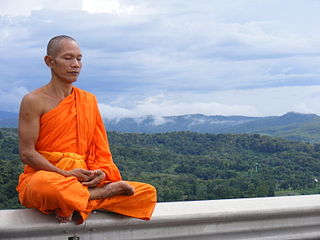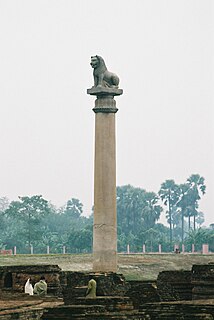
The Noble Eightfold Path is an early summary of the path of Buddhist practices leading to liberation from samsara, the painful cycle of rebirth.

Theravāda is the most ancient branch of extant Buddhism today, and the one that preserved their version of the teachings of Gautama Buddha in the Pāli Canon. The Pāli Canon is the only complete Buddhist canon which survives in a classical Indian language, Pāli, which serves as both sacred language and lingua franca of Theravāda Buddhism. For more than a millennium, Theravāda has focused on preserving the dhamma as preserved in its texts, and it tends to be very conservative with regard to matters of doctrine and monastic discipline. Since the 19th century, meditation practice has been re-introduced, and has become popular with a lay audience, both in traditional Theravada countries and in the west.

In Buddhism, the term anattā (Pali) or anātman (Sanskrit) refers to the doctrine of "non-self", that there is no unchanging, permanent self, soul or essence in living beings. It is one of the seven beneficial perceptions in Buddhism, and along with dukkha (suffering) and anicca (impermanence), it is one of three Right Understandings about the three marks of existence.

Rebirth in Buddhism refers to its teaching that the actions of a person lead to a new existence after death, in endless cycles called saṃsāra. This cycle is considered to be dukkha, unsatisfactory and painful. The cycle stops only if liberation is achieved by insight and the extinguishing of desire. Rebirth is one of the foundational doctrines of Buddhism, along with Karma, nirvana and moksha.

Buddhists take refuge in the Three Jewels or Triple Gem.

Since the death of the historical Buddha, Siddhartha Gautama, Buddhist monastic communities have periodically convened to settle doctrinal and disciplinary disputes and to revise and correct the contents of the sutras. These gatherings, referred to by historians as 'Buddhist councils', are recorded in the Buddhist sutras as having begun immediately following the death of the Buddha and have continued into the modern era.

The Pratimokṣa is a list of rules governing the behaviour of Buddhist monastics. Prati means "towards" and mokṣa means "liberation" from cyclic existence (saṃsāra).

Buddhism is the world's fourth-largest religion with over 520 million followers, or over 7% of the global population, known as Buddhists. Buddhism encompasses a variety of traditions, beliefs and spiritual practices largely based on original teachings attributed to the Buddha and resulting interpreted philosophies. Buddhism originated in ancient India as a Sramana tradition sometime between the 6th and 4th centuries BCE, spreading through much of Asia. Two major extant branches of Buddhism are generally recognized by scholars: Theravada and Mahayana.

Merit is a concept considered fundamental to Buddhist ethics. It is a beneficial and protective force which accumulates as a result of good deeds, acts, or thoughts. Merit-making is important to Buddhist practice: merit brings good and agreeable results, determines the quality of the next life and contributes to a person's growth towards enlightenment. In addition, merit is also shared with a deceased loved one, in order to help the deceased in their new existence. Despite modernization, merit-making remains essential in traditional Buddhist countries and has had a significant impact on the rural economies in these countries.
In Buddhism, the eight precepts is a list of precepts that are observed by lay devotees on observance days and festivals. They include general precepts such as refraining from killing, but also more specific ones, such as abstaining from cosmetics. Probably based on pre-Buddhist brahmanical practices, the eight precepts are often upheld on the Buddhist observance days, and in such context called the uposatha vows or one-day precepts. They are considered to support meditation practice, and are often observed when staying in monasteries and temples. In some periods and places, such as in 7th–10th-century China, the precepts were widely observed. In modern times, there have been revival movements and important political figures that have observed them continuously.

Brahmā is a leading god (deva) and heavenly king in Buddhism. He was adopted from other Indian religions such as Hinduism that considered him a protector of teachings (dharmapala), and he is never depicted in early Buddhist texts as a creator god. In Buddhist tradition, it was the deity Brahma Sahampati who appeared before the Buddha and urged him to teach, once the Buddha attained enlightenment but was unsure if he should teach his insights to anyone.
In English translations of Buddhist texts, householder denotes a variety of terms. Most broadly, it refers to any layperson, and most narrowly, to a wealthy and prestigious familial patriarch. In contemporary Buddhist communities, householder is often used synonymously with laity, or non-monastics.

The Uposatha is a Buddhist day of observance, in existence from the Buddha's time, and still being kept today in Buddhist countries. The Buddha taught that the Uposatha day is for "the cleansing of the defiled mind," resulting in inner calm and joy. On this day, both lay and ordained members of the sangha intensify their practice, deepen their knowledge and express communal commitment through millennia-old acts of lay-monastic reciprocity. On these days, the lay followers make a conscious effort to keep the Five Precepts or the eight precepts. It is a day for practicing the Buddha's teachings and meditation.
Transfer of merit is a standard part of Buddhist spiritual discipline where the practitioner's religious merit, resulting from good deeds, is transferred to deceased relatives, to deities, or to all sentient beings. Such transfer is done mentally, and it is believed that the recipient can often receive this merit, if they rejoice in the meritorious acts of the person transferring. In Buddhism, merit transfer is seen as a better alternative than mourning.

Skandhas (Sanskrit) or khandhas (Pāḷi) means "heaps, aggregates, collections, groupings". In Buddhism, it refers to the five aggregates of clinging (Pancha-upadanakkhanda), the five bodily and mental factors that take part in the rise of craving and clinging. They are also explained as the five factors that constitute and explain a sentient being’s person and personality, but this is a later interpretation in response to sarvastivadin essentialism.

Theravada Buddhism defines arhat as one who has gained insight into the true nature of existence and has achieved nirvana. Other Buddhist traditions have used the term for people far advanced along the path of Enlightenment, but who may not have reached full Buddhahood.

In the Buddha's first discourse, he identifies craving (tanha) as the cause of suffering (dukkha). He then identifies three objects of craving: the craving for existence; the craving for non-existence and the craving for sense pleasures (kama). Kama is identified as one of five hindrances to the attainment of jhana according to the Buddha's teaching. Throughout the Sutta Pitaka the Buddha often compares sexual pleasure to arrows or darts. So in the Kama Sutta from the Sutta Nipata the Buddha explains that craving sexual pleasure is a cause of suffering.
If one, longing for sensual pleasure, achieves it, yes, he's enraptured at heart. The mortal gets what he wants. But if for that person — longing, desiring — the pleasures diminish, he's shattered, as if shot with an arrow.












